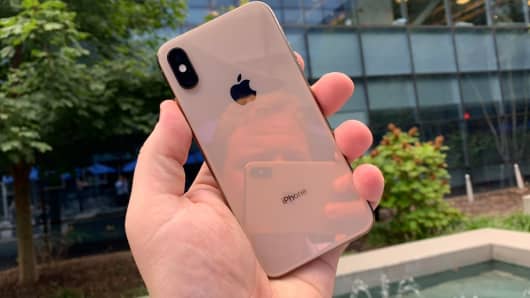I've been testing two of Apple's three new iPhones over the past several days: the iPhone XS and the iPhone XS Max. They're the best iPhones Apple has ever made, and also the most expensive. The fully loaded iPhone XS Max with 512GB of storage costs $1,449, for example, which is more than some MacBooks.
But apart from the bigger screen on the Max, I've had a hard time really noticing a huge improvement over last year's iPhone X, which I still love. And if you want to save some money, you should wait for Apple's more affordable model — the iPhone XR — which starts at $749 and launches in October.
I'll dig through what you need to know about the phones, but here's the gist: they're so much like last year's iPhone X that most people probably won't be able to tell the XS and the X apart.
What's good
The iPhone X, even a year later, is still arguably the best phone on the market. The XS is basically a new model with some improvements.
Most of those improvements, though, are kind of hard to notice.
Take the screen, for example. It's still a brilliant, colorful and sharp OLED display that supports next-gen HDR 4K video. It's one of the best screens on the market, up there with the display on the Samsung Galaxy Note 9. But some of the improvements, like its increased dynamic range, can only be spotted when viewing photos. And even then, I don't think most folks will notice. This isn't bad; it just means the screen is still really good and we're getting to a point where it's hard to distinguish upgrades.
The speakers sound awesome. They're louder than the iPhone X, and Apple also worked to tune the stereo sound so that audio sounds wider or more narrow, depending on the scene. This means movies, games and music will sound much better when you're watching in landscape mode.
By getting rid of the bezels, the black borders around the display, with last year's X, Apple managed to squeeze a large 5.8-inch screen into a pocketable form factor. Years ago people balked at a 5.8-inch screen. But now it feels ordinary.
The larger iPhone XS Max has a 6.5-inch screen, which is bigger than the 6.4-inch on the massive Galaxy Note 9, but it still doesn't feel too big to me. It's the device I prefer of the two, and I love reading the news or filling out a crossword on the bigger screen.
The rest of the design is basically identical to the iPhone X. You have stainless steel running along the top and sides, which gives it a premium look to match the price. I love how shiny it is on the new gold and white models. Apple says the glass on the front and back is the strongest it's ever used in a phone, and even more scratch- and shatter-resistant than the iPhone X. I'm still afraid of cracking it, as I did on a small part of my personal iPhone X, so I kept them in cases most of the time. The glass also allows you to place the phone on a wireless pad to charge it instead of plugging it in, just like with last year's model.
The camera is very good. I was impressed with the iPhone X and the Galaxy Note 9, but the iPhone XS pictures looked better to me.
Apple said it upgraded the camera sensor that's over 30 percent larger, which means it lets in more light. Also, high dynamic range (HDR) photos can be snapped twice as fast, so there isn't the delay you see in other phones, and shadows are clearer. I also liked that I could take portrait pictures, like shots of my dog on the beach, and adjust the background blur after the fact.
So a picture like this:
Can also look like this:
Notice how there's more blur, or bokeh, in the second one. Previously, you couldn't do this on an iPhone after snapping a picture.
The extra 2x telephoto lens is really useful for when you want a quick zoom and can't move in closer, and it's a feature you won't find in the cheaper iPhone XR.
Apple improved the water-resistance of the iPhone Xs and iPhone Xs Max, too, so Apple says you don't have to worry about spilling on it, or even dropping it in a pool. It can sit in 3 feet of water for up to 30 minutes, like Samsung's latest phones. I didn't want to ruin my test unit, but left it in a fountain about 1 foot deep for 5 minutes and it was totally fine after I took it out. That's better than the iPhone X, too, which could withstand spills and splashes but shouldn't really spend much time in water.
Lastly, the battery life is really good on the iPhone XS and iPhone XS Max, but note that I've only been using them for a few days. My iPhone X had great battery life at first, but now seems to die long before the day is over. Apple says the iPhone XS offers 30 minutes longer battery life than its predecessor, while the iPhone Xs Max offers a full 1.5 hours of additional battery life over the iPhone X.
I drained the iPhone XS Max before bedtime only once during my testing, and that's because I pretty much used it non-stop while installing apps and configuring the phone.
iOS 12
Apple's new iPhones run iOS 12, which is loaded with new features.
Siri is improved and you can train it with a new "Siri Shortcuts" feature. It lets you do more with Siri than before, because you basically train it to answer your commands. For instance, I taught Siri so that every time I say "Hey Siri, say cheese," the camera opens. I also used it to automatically dial-in to a conference number and to automatically start a playlist and bring up directions to work.
There's also a bunch of new Animoji, which use the front-facing camera to mimic your face. And, you can create new "Memoji," which is basically a digital cartoon version of yourself that you can send to people in Messages. I had a lot of fun creating my own Memoji, which I think actually look a bit like me unlike competing solutions from Samsung.
iOS 12 also adds improvements to speed throughout the iPhone user interface. I always thought iOS was pretty fast on my iPhone X, and it's kind of hard to notice a real difference.
There are lots of other changes in iOS 12, like Screen Time that shows you how often you use some apps. That also lets you manage how long you use an app each day, in case you want to limit yourself to an hour of Facebook, for example. They work, but I don't use them to limit my own time.
Also, I love that iOS 12 gives you so much more control over notifications. You can turn off individual app notifications much easier -- right from the pop-up -- and even have everything grouped together so you don't have 40 individual notifications from a single app, like News. On the same note, a new Quiet Time feature is a blessing for me, since I can silence all notifications at night, only allowing important ones -- like a call from a family member-- through.
What's not good
I don't have too many complaints with either the iPhone XS or the iPhone XS Max.
My biggest, though, is that while Apple supports faster-charging, the charger in the box is insanely slow. With most Android phones, I can plug in my phone, take a shower, and know that I have enough battery to get me several more hours of battery life. With the iPhone XS and iPhone XS, unless I use a bigger charger like the one included with the iPad, I don't get that same experience.
Apple told me that lots of its customers actually prefer the tiny charger to larger ones, since it's so compact and can be carried anywhere. I'd much rather have a bulky charger that juices the phone up quicker. Still, the convenience of something like a wireless charging pad is also a nice benefit.
The phones can also be awfully expensive if you want a lot of storage. The 512GB iPhone XS Max, which I had my eye on, costs more than $1,400. I just can't swallow spending that much money, so I went with the slightly more affordable 256GB model when I ordered my own earlier this week.
If price is a concern to you, then you really should wait and see what the iPhone XR is like. I only had a chance to spend a few minutes with it after Apple's keynote, but it has the same processor and seems to still have a really good camera, just without things like the hardware zoom lens. It starts at $749, comes in five colors and has a 6.1-inch screen that's larger than the iPhone XS. It's an LCD display, like the iPhone 8 and earlier, which is still fine but just not as good at showing colors and dynamic range as an OLED screen.












